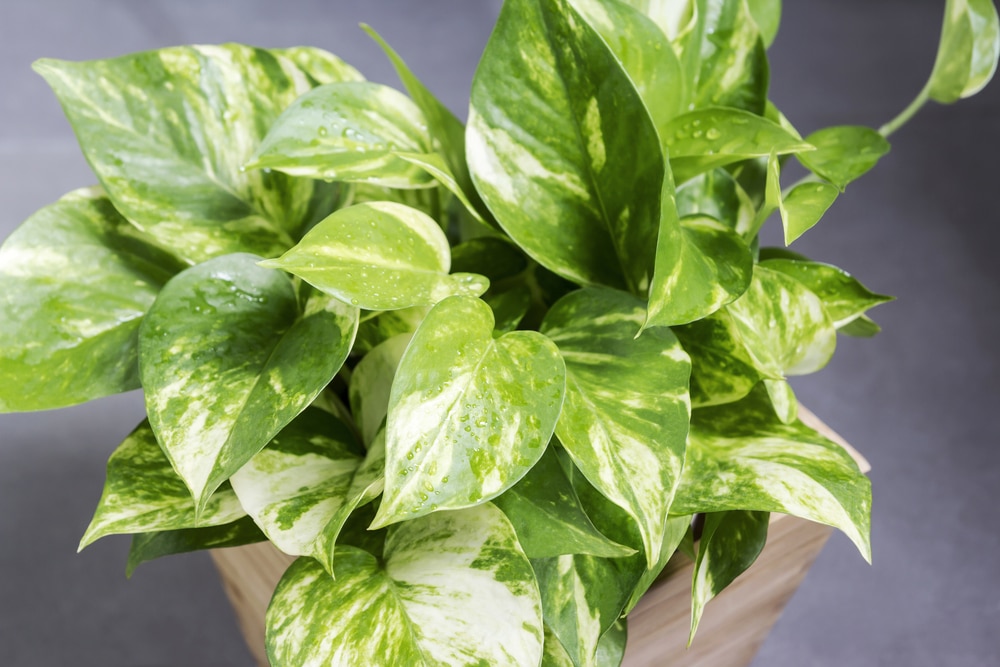Pothos plants are hardy and beautiful and you might not know that most of them are related. The natural species is Epipremnum aureum pothos, also known as ‘Golden pothos’ or ‘Devil’s Ivy’, but these robust plants have a variety of cultivars in some beautiful colors that you really have to see to believe.
Today we’ll tell you about 15 of them, including a few which are commonly referred to as pothos plants but technically a very different plant altogether. We’ll also give you some information on their proper care and by the time we’re finished, you can start looking for a pothos or two of your very own.
Without further ado, let’s take a look as some of the many variations of pothos that you can find!
Pothos Varieties to Consider for Your Home
- Cebu Blue pothos – Epipremnum pinnatum
- Golden pothos – Epipremnum aureum ‘Golden’
- Glacier pothos – Epipremnum aureum ‘Glacier’
- Hawaiian pothos – Epipremnum aureum ‘Hawaiian’
- Jade pothos – Epipreum aureaum ‘Jade’
- Jessenia pothos – Epipreum aureaum ‘Jessenia’
- Trebi pothos – Scindapsus pictus ‘Trebi’
- Manjula pothos – Epipreum aureaum ‘Manjula’
- Marble Queen pothos – Epipreum aureaum ‘Marble Queen’
- Neon pothos – Epipreum aureaum ‘Neon’
- N-Joy Pothos – Epipremnum pinnatum ‘Njoy’
- Pearls and Jade Pothos – Epipremnum pinnatum ‘Pearls and Jade’
- Silver pothos – Scindapsus pictus ‘Silver’
- Snow Queen pothos – Epipremnum aureum ‘Snow Queen’
- Harlequin Pothos – Epipremnum aureum ‘Harlequin’
Cebu Blue pothos – Epipremnum pinnatum
First off, we have the Cebu Blue, and this one is a beauty! This one is not an aureum variety, but it is still quite popular for it’s silvery-blue leaves and low care and maintenance. Originally from the island of Cebu in the Philippines, this cultivar may now be found in many parts of the world and you can definitely get one of your own.
In nature, these plants can get anywhere from 4 to 40 feet, but when you grow it indoors then it will rarely get to a length in the double-digits. Just keep in mind that you might need to trim it from time to time and to keep this plant away from kids and pets – this beauty is toxic!
Standard potting mix will work, but you want to add perlite and orchid bark for best results with your Cebu Blue. It also will do okay in medium, indirect sunlight, but you’ll get the best growth rate if the light is indirect and bright. Watering should be done once a week or whenever the top 2 inches of soil have thoroughly dried out.
Golden pothos – Epipremnum aureum ‘Golden’
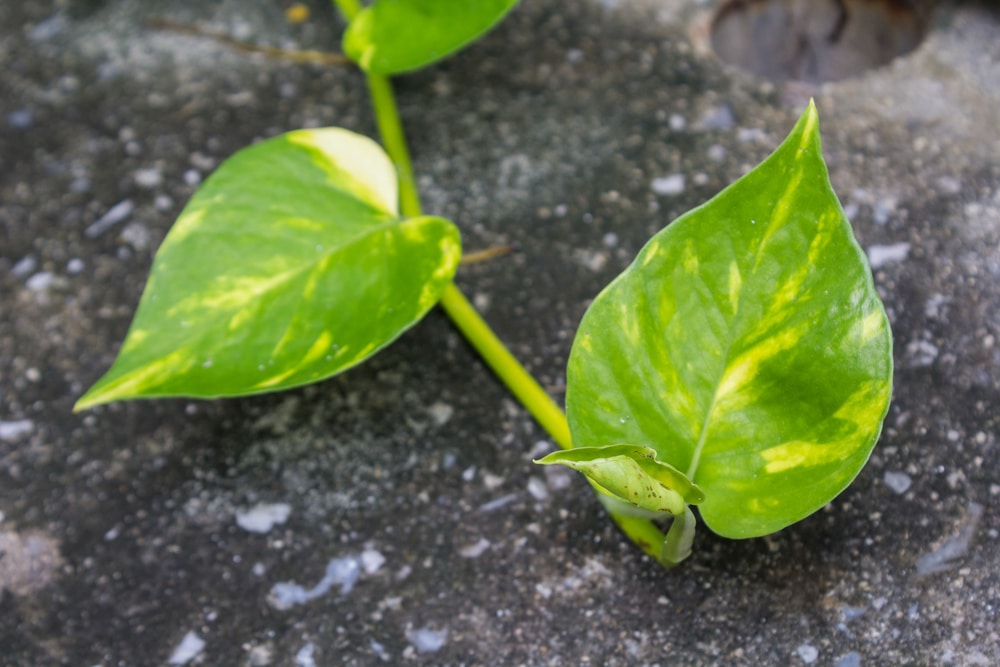
While it’s the most common variety of pothos, the glossy-green leaves with yellow highlights of the Golden pothos make it the most popular variety in the world. While it can grow in a range of 20 – 40 feet, as long as you prune it from time to time your plant is still going to be big in beauty and small in maintenance.
While it will grow in just about any soil, Golden pothos will be happiest if you add some perlite and peat moss into the mix. After that, just give it lots of bright and indirect sunlight and water it once a week in the warmer months and about twice a week in winter – just check the topsoil to ensure that the top 2 inches are fully dry.
Glacier pothos – Epipremnum aureum ‘Glacier’
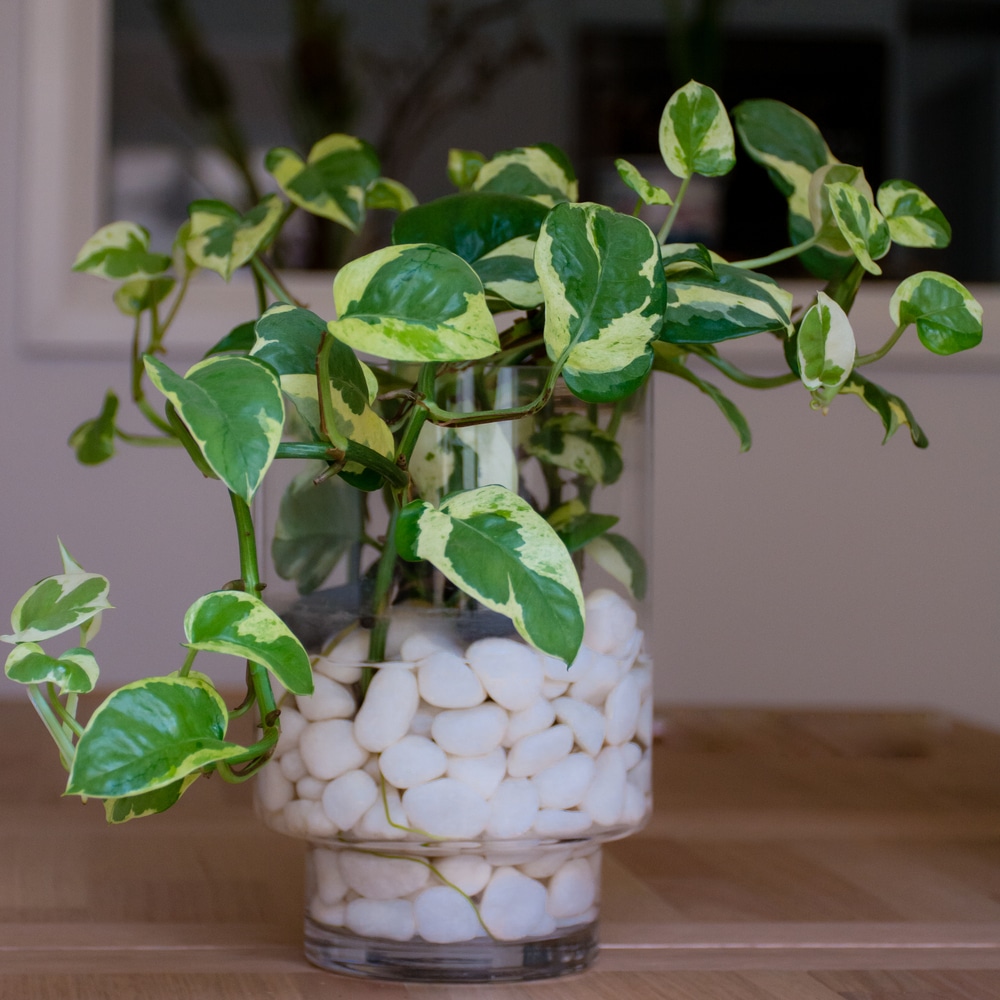
Slow growing and tolerant of low light, the Glacier pothos is a beautiful cultivar that sports green leaves with speckles of silver and gray on them. Like other aureums, it will eventually get quite large, but this particular cultivar takes a lot more time doing it and thus makes less demands on your own time.
This plant does well with a mix of 2/3 regular potting soil to ¼ part perlite and while bright, indirect sunlight and humidity will help it to grow at it’s fastest rate, it will still tolerate lower light and humidity levels (just mist the leaves from time to time). As far as watering, check the top 2 inches of soil, but the average frequency will be every 5 to 8 days.
Hawaiian pothos – Epipremnum aureum ‘Hawaiian’
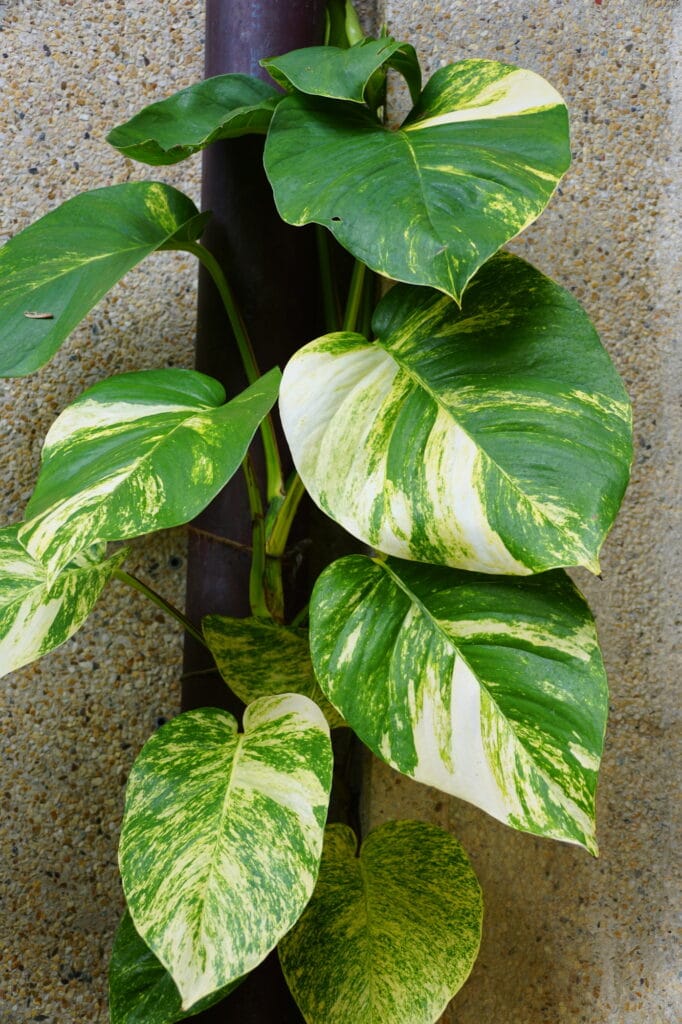
Hawaiian pothos is a definite attention-getter, as this variety has long vines and larger leaves than most other pothos plants you will find. While the leaves will certainly be bigger if you grow them outside, even an indoor Hawaiian pothos will produce some that will impress you,
Care is easy, with soil requirements amounting to a handful of perlite and regular potting soil. Bright, indirect light and a watering frequency of every 5 to 7 days (provided the topsoil is dry) are the only other requirements to enjoy this impressive pothos in person!
Jade pothos – Epipreum aureaum ‘Jade’
Jade pothos is another of the most common varieties that you’ll find out there and it has heart-shaped leaves of dark green that will look quite impressive as your pothos grows in it’s hanger. While it can grow up to 30 feet, it’s still quite manageable indoors and it won’t require a whole lot of your time to take care of it.
A quick soil base for this plant would be cactus or succulent soil, with a little perlite thrown in to help ensure the best drainage. While it’s happiest with bright and indirect sunlight, this variety will tolerate medium or even low light as well, so you have a lot more range where you can display it in your home. Water it once a week when it’s warm and once every 2 weeks in the winter and you’ll have a healthy, happy pothos plant!
Jessenia pothos – Epipreum aureaum ‘Jessenia’
With emerald leaves which are splashed with marbling patterns of yellow, this relative newcomer to pothos cultivars has become quite popular indeed. Especially since it’s a slow grower. You can expect it to get up to 30 feet in length outside, but indoors it should top out at around 10.
Regular potting soil with a mix of perlite for superior drainage is a perfect home for this plant and you’ll want to give it lots of bright, indirect sunlight if you want it to grow it’s fastest. This one is also tolerant of temperatures as low as 55 degrees, so it’s going to be very forgiving of its environment.
Watering should be done every 3 to 7 days, depending on the dryness of the top 2 inches of soil. Check with your fingers and if it’s dry, then it’s time to water your Jessenia pothos.
Trebi pothos – Scindapsus pictus ‘Trebi’
This pothos is not technically a pothos, despite its common name. It’s a close relative of the ‘Satin pothos’ and it’s distinctive in that it have silvery blue leaves with some marbling that will really get your attention. It’s also less ‘dramatic’ in color, as far as brightness, so this might be a perfect match for a room with a touch of dark décor to it.
Grown indoors, you can expect this cultivar to grow to be about 3 feet, and outdoors it might get as much as 10 feet long. For your soil mix, go with equal parts of perlite, regular potting soil, and peat moss
While it is tolerant of all levels of indirect sunlight, it will grow the fastest if you give it a bright, indirect source. Watering should be done when the top half of the soil is dry, so you will likely have to water it around once every 7 to 8 days.
Manjula pothos – Epipreum aureaum ‘Manjula’
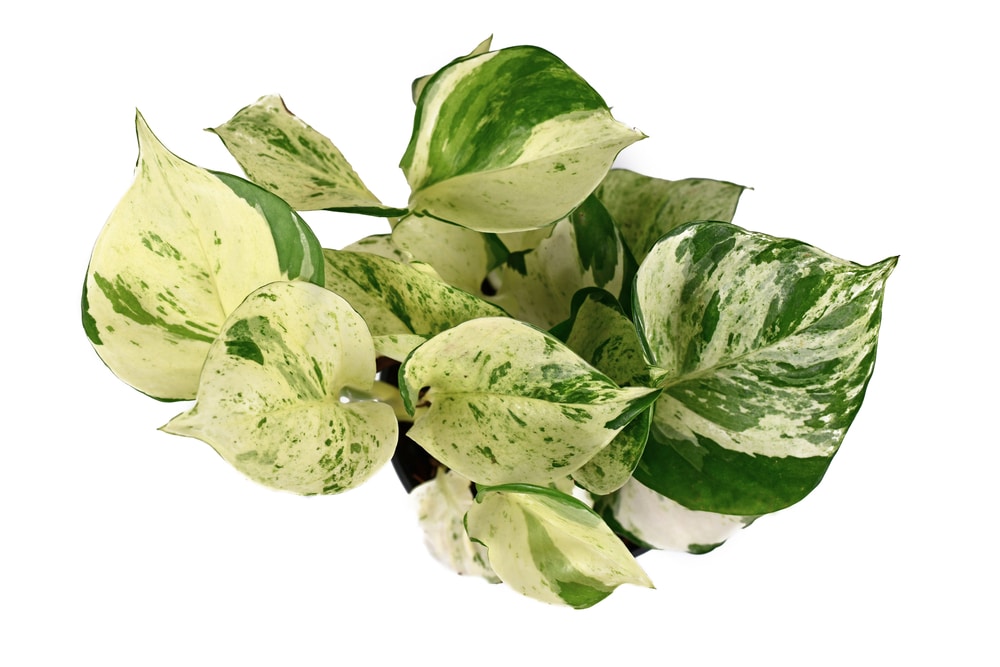
Also known as the ‘Happy Leaf’ pothos, Manjulas have lovely cream-colored leaves that are sometimes almost completely white, while others are a green and white mix. They definitely look amazing, but you’ll need to put a little extra work in to keep them looking their best.
Indoors, your plant should grow to be about 6 feet long at maximum, making it a perfect little addition to a drab corner of the house that could use a little kiss of nature.
Regular potting soil is actually perfect for this variety, and you’ll want to give it medium or bright-but-indirect sunlight. Watering is quite different, as you’ll need to test the top 2 inches of soil and then add only about an inch of water every 2 to 3 weeks.
It doesn’t need much, it’s just got a very different watering frequency and volume from other pothos and that might take a little getting used to.
Trust us, it’s well-worth it!
Marble Queen pothos – Epipreum aureaum ‘Marble Queen’
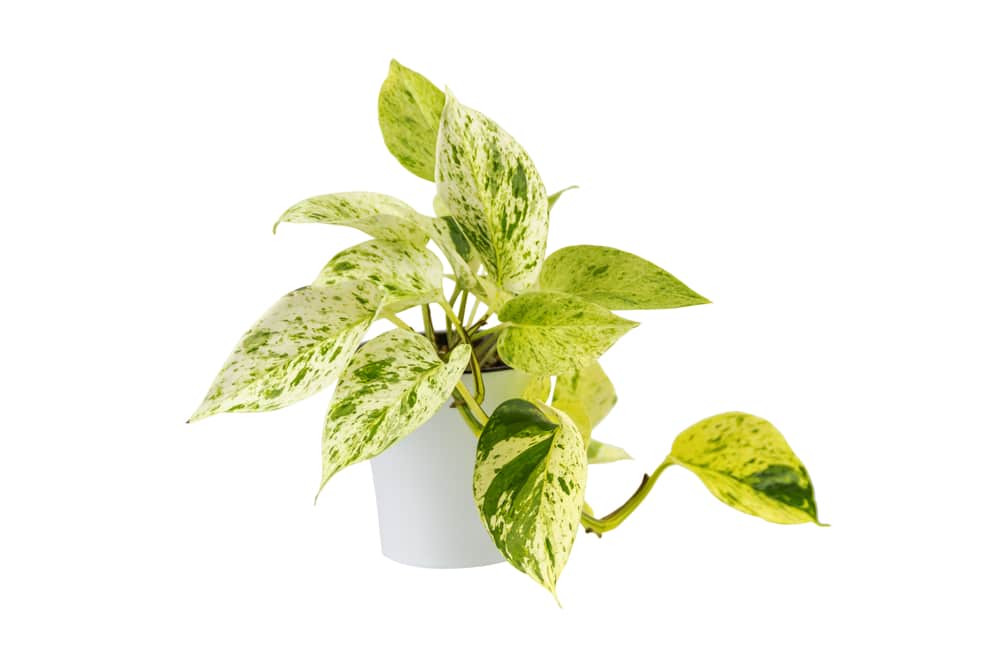
The Marble Queen is one good-looking plant, with leaves which are spade-shaped and mostly white with a green marbling effect to them. It also happens to be a slow grower, so it’s super easy to have one in your home. Indoors, it will eventually reach a length of up to 10 feet, but it’s going to take awhile.
Regular potting soil will work for this plant, but you can get a better growth rate with a mix of equal parts peat moss, perlite, and standard potting soil. After that, just give it indirect sunlight which is bright or at least medium level and water it once a week when the top inch or two of your soil is dry.
Neon pothos – Epipremnum aureum ‘Neon’
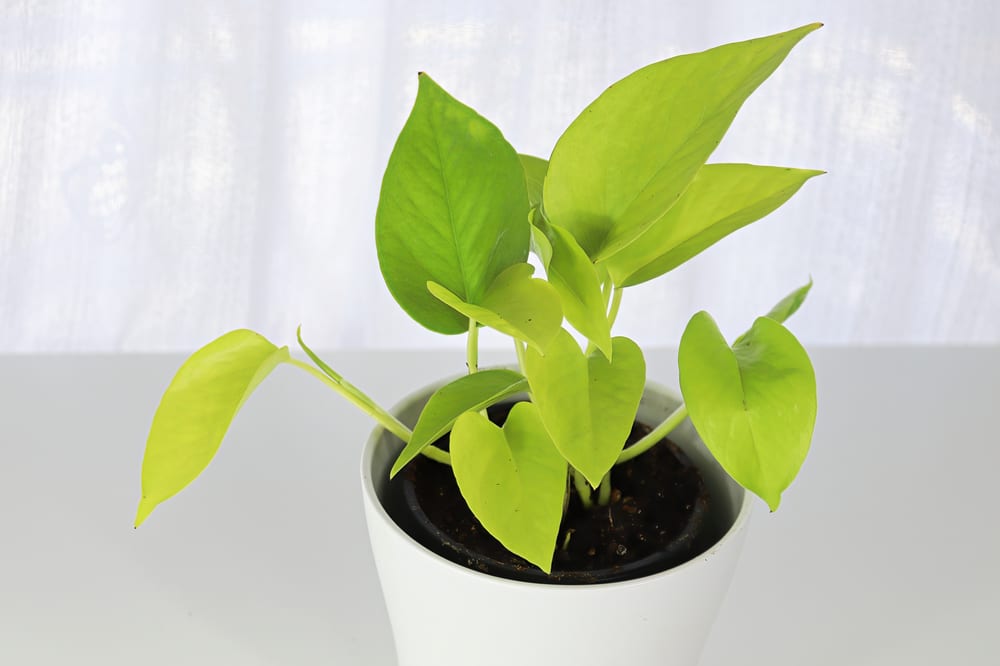
Green, but not the dark kind, Neon pothos really lives up to it’s name. The large, lush, and light-green leaves will really draw the eye quickly and it will definitely add a little life wherever you decide to put it.
Neons will get up to 10 feet in length indoors and they are very forgiving when it comes to care.
House them in a soil mix of standard potting soil and perlite and you’ll want to give your Neon bright, indirect sunlight. You want to keep the soil moist, but not wet – every 5 to 7 days a single watering should be fine, just check the top 2 inches for dryness and you’ll soon learn the perfect frequency for your plant.
NJoy Pothos – Epipremnum pinnatum ‘Njoy’
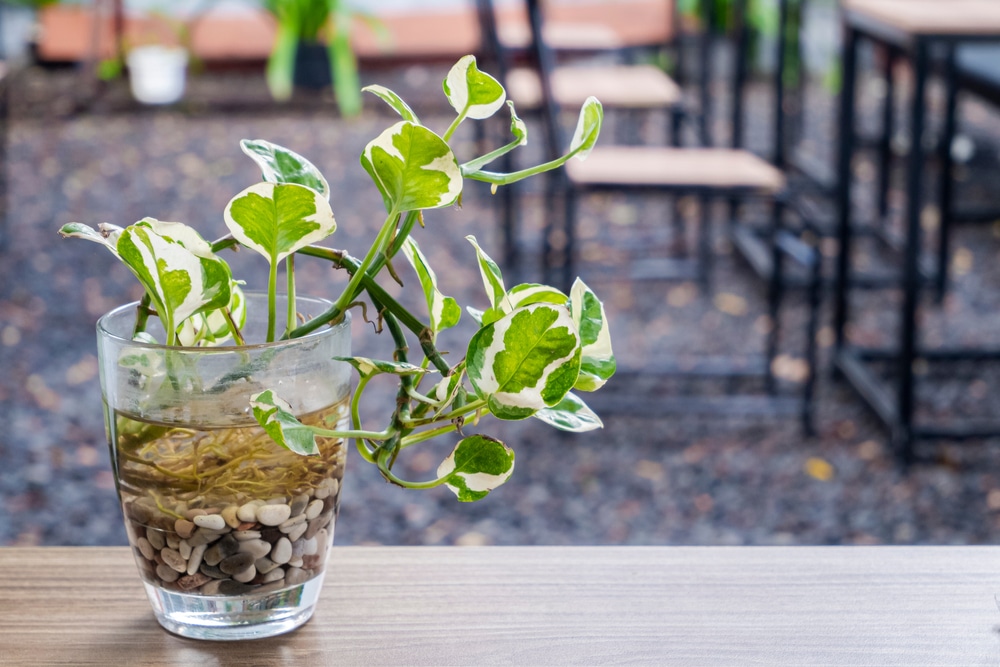
Often confused as the ‘pearls and jade’, the Njoy pothos is actually a different plant with the distinction being that this cultivar has a mix of green and white leaves but the white portions will be completely white. It’s a good-looking plant and the Njoy cultivar should reach a maximum of 10 feet in length, but only around 6 to 9 inches tall.
A half and half mi of peat and perlite makes a perfect home if you’d like an NJoy of your own and bright, indirect sunlight is best – but medium is fine too! Small amount of indirect sunlight will whiten the leaves as well, just keep it to a minimum for your plant’s health.
Watering is also quite minimal for this plant, with the recommendation being that the last inch or two of soil at the bottom should be dry before watering.
Pearls and Jade Pothos – Epipremnum pinnatum ‘Pearls and Jade’
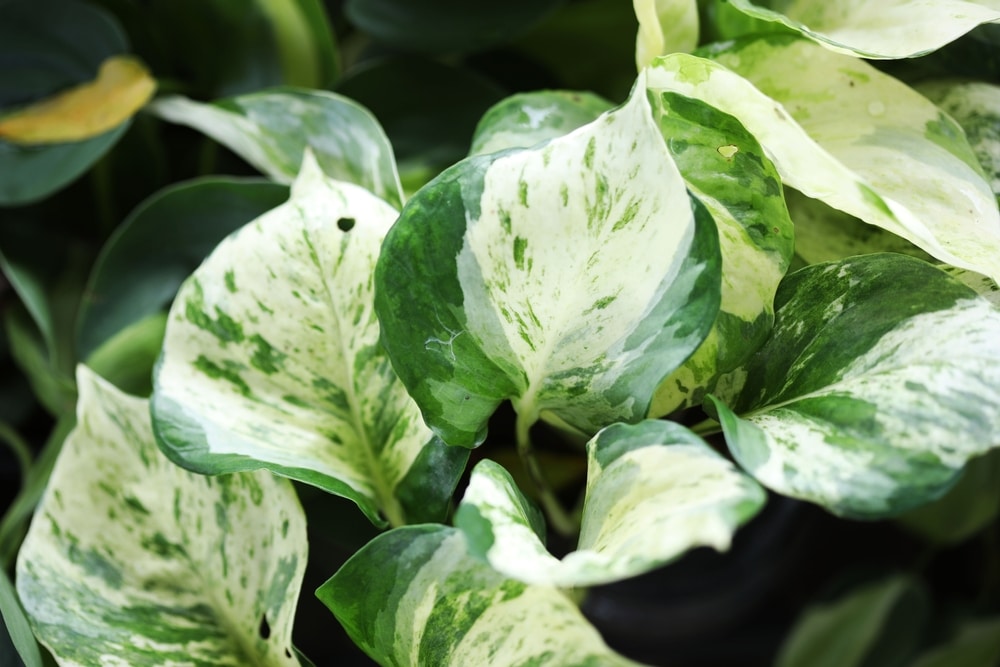
The Pearls and Jade pothos has smaller leaves than many of the varieties we’ve mentioned here and they will be mostly green, with outlines of white and white and green mix. This beauty is also a slow grower, so you can stick one on the desk if you like and you’ll have very little maintenance to keep up with.
Indoors, it will reach lengths of 6 to 10 feet in total, and this pothos likes s well-draining soil so give it regular potting soil with a healthy dash of perlite. This plant will do best in bright, indirect sunlight, but it will grow in even low levels of light, so you can put it just about anywhere in the house where there’s a window nearby.
Check the top 2 inches of soil for dryness, but it will only need water every 1 or 2 weeks!
Silver pothos – Scindapsus pictus ‘Silver’
Silver pothos is more commonly known as ‘satin pothos’ and has large, spade-shaped leaves with a minor white or silver outline and lovely splotches of beautiful silver color. The patterning is often quite exquisite, and the combination of this and the ease of care for this plant makes it a popular choice for many nature-friendly homes.
At most, this plant will be between 4 and 8 feet long, so it won’t take a lot of pruning either. Just house it in a soil which is an equal mix of peat, perlite, and standard potting soil and your plant will be quite happy with you.
This plant likes lots and lots of bright and indirect sunlight but it doesn’t need a lot of water. Let the soil dry out between waterings and expect a frequency of once every 1 or 2 weeks
Not a bad trade at all, we think!
Snow Queen pothos – Epipremnum aureum ‘Snow Queen’
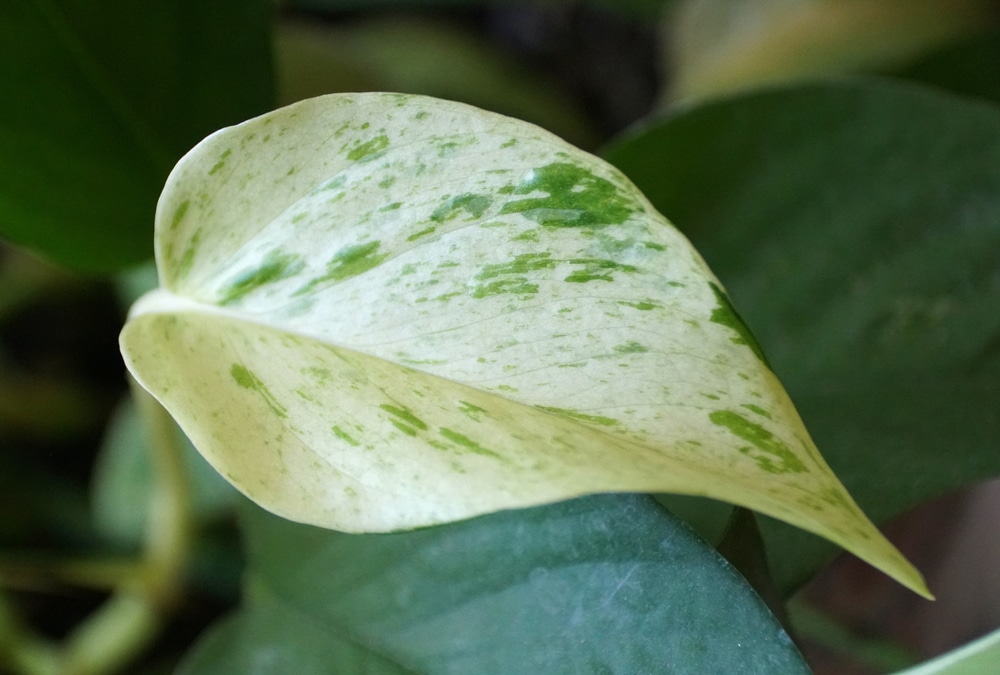
The Snow Queen Pothos is much like the Marble Queen, but you get more white coloration in the patterning of the leaves, This can make for quite the lovely and dramatic look, making this a very popular cultivar indeed. Like many of the aureums, you can expect a fully mature size of 6 to 10 feet long if you take care of it, and said care is actually quite minimal.
Give this plant 2 parts regular potting soil to 1 part perlite and at least 4 hours of bright and indirect sunlight for best results. Let the soil dry out completely between waterings and you’ll likely have a watering frequency of once every 6 to 8 days.
Harlequin Pothos – Epipremnum aureum ‘Harlequin’
Possibly the rarest potho out there is the Harlequin pothos and it is basically a cultivar with properties of Manjula, Jessenia, and Marble Queen. The result is a dazzling mix of heavy white color with dark green that is obviously cultivated but no less spectacular for it. They are so rare these days that it’s hard to give you a lot of info on them, but once you see the pictures then you can see for yourself – they’re really quite striking.
As they are an aureum cultivat, expect a length of 6 to 10 feet, and the best potting soil needs to drain well. Give it standard potting soil with a hefty handful of perlite and lots of bright, indirect sunlight. Water every 5 to 8 days, as long as the top 2 inches of topsoil have dried out, and be sure to show it off – this may well be the hardest pothos to find, so you’re going to be the envy of your green-thumb friends!
Some Final Words
As you can see, the ‘Devil’s Ivy’ comes in many shapes and forms, all of which are quite beautiful and easy to keep. These vines do well in a hanging planter or on your desk and will require very little maintenance on your part to add an incredible amount of beauty to your home. Whether you go with the common garden variety or find yourself a Harlequin, the end result is pretty much guaranteed.
You’ll have a beautiful pothos cultivar that will brighten up the house for many years to come! Just be sure to share your pictures, because not enough people know how easy it can be to add that extra dimension of nature to their home.
So, what are you waiting for? Your perfect pothos is waiting!
